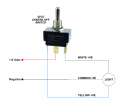Hi brains trust,
Total Newbie, sorry moderator if posted to wrong forum.
Most RV's install White light and would love a take advantage of using amber lights as well. Amber helps with detracting bugs.
Attached is a schematic that shows how to convert a typical positive/negative 12v single color light into using dual colors if the light has both led's installed.
Question, I don't understand the schematic and would be grateful if someone could explain how to layout the diodes and solder the cables back, lastly, the cabling to the dpdt switch. If anyone is able to show on photos how this works, I'd appreciate the effort because this is over my head.
Products required
1 x DPDT switch
Diodes
and of course the Amber/White light
Total Newbie, sorry moderator if posted to wrong forum.
Most RV's install White light and would love a take advantage of using amber lights as well. Amber helps with detracting bugs.
Attached is a schematic that shows how to convert a typical positive/negative 12v single color light into using dual colors if the light has both led's installed.
Question, I don't understand the schematic and would be grateful if someone could explain how to layout the diodes and solder the cables back, lastly, the cabling to the dpdt switch. If anyone is able to show on photos how this works, I'd appreciate the effort because this is over my head.
Products required
1 x DPDT switch
Diodes
and of course the Amber/White light
Attachments
-
30.8 KB Views: 31
-
23 KB Views: 30












